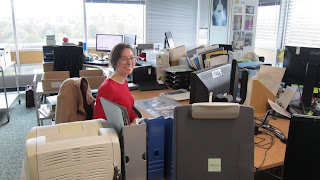This week, we welcome a new Archive Intern to the LHSA team and, if you're a regular follower of the blog, you may recognise her!
Hi there! I am Vannis Jones, the latest LHSA archive intern, and like many
before me, I too have just completed my MSc in Information Management and
Preservation at the University of Glasgow. I have been a weekly volunteer in
LHSA for a year and ten months (!), so I am delighted to make the jump to an
official member of staff, albeit temporarily. My past projects at LHSA have
been extremely varied and have included cataloguing small personal collections,
oral histories, drawings of surgical instruments (for more about this, see my previous blog post),
administrative haematology records, and more. I have also had the opportunity
to use Encoded Archival Description, an XML-based standard for encoding
archival finding aids, to catalogue tuberculosis case notes.
 |
| At my desk in the office |
This internship, however, focuses on a medium with which I
have little professional experience—photographs. I have catalogued and rehoused
the odd photograph in various smaller general deposit collections at LHSA, but
I have never had the opportunity to work with a large body of photographs. In
this internship, I will be addressing the photograph cataloguing backlog,
beginning first with photographs that have been assigned identifiers using a
legacy numbering system. Once these photographs are fully catalogued in line
with LHSA’s current practices, I will move on to the body of photographs that
are entirely uncatalogued. The fun of photograph cataloguing is that
photographs tend to be a bit more challenging to decipher than other
documentary evidence. It is not at all uncommon for photographs to have no
label, date, or any other contextual information to assist in determining its
provenance or writing an archival description. This requires a great deal of
resourcefulness and creative thinking in order to interpret any visual clues
that are present in the photograph. An example from past projects would be
photographs of Red Cross nurses—the designs of their uniforms have changed over
time, and by comparing photographs of the nurses with online Red Cross
resources, it is possible to date these photographs to a relatively high degree
of accuracy. I believe this detective work will be one of the greatest (and
most exciting) challenges of this project.
 |
| Nurses and male staff member from the Edinburgh Royal Maternity Hospital, 1900s (P/PL3/S/061) |
Throughout my internship I will also have some exciting
professional development opportunities, including liaising with the conservation intern (who you'll hear from next week) on a
smaller project or two, visiting other Edinburgh and Lothian repositories, and attending
talks related to archives and conservation, to name a few. I am looking forward
to further honing my skills I have developed over the past two years during
this internship, and I can’t wait to see what fun, quirky, puzzling, and unique
photographs await me!



